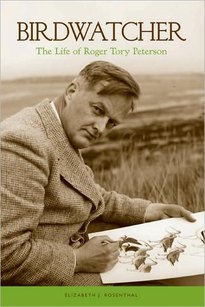Reviewed by Grant McCreary on May 29th, 2008.
I would think that most everyone, and certainly anyone with even the slightest bit of interest in nature, and especially birds, has heard the name Roger Tory Peterson. Or if not, are aware of the Peterson field guides. The Peterson field guide to birds was even mentioned on an episode of the Simpsons (“Roadrunners are real?!?”). As a kid who was into most things nature, I was certainly aware of the name. At one point, I even considered writing the man to ask if a certain bird I had seen was likely a Pine Warbler, as I suspected it was. As an adult looking back on that, I can only shake my head at the naiveté of childhood. Due to the enormous responsibilities of the man, it is doubtful I would have gotten a reply. However, after reading this book it is apparent that he would have loved to talk with any kid interested in birds.
Roger Tory Peterson probably did more for the cause of conservation than any other person in history. The amazing thing is that he accomplished this not by rallying people to the cause directly (although he did indeed do that from time to time), but instead by making nature accessible to everyone. And when it was accessible, it had value. He achieved this through the genius of his field guide. His 1934 A Field Guide to the Birds was not the first book dealing with bird identification. But it was the first to make it easy for the general person to identify most birds. It was this book, its subsequent editions, and the line of other Peterson guides (most of which he did not write or illustrate) that he was most known for. However, as this biography makes abundantly clear, there was much more to the man than the field guides that bear his name.
Rosenthal takes us from Peterson’s early days to his death in 1996, and even beyond through his legacy. His development, field guide, conservation efforts, friendships, and those he influenced are treated prominently. The reader will discover the influences that lead to the creation of his field guide, and his need to revise it continually. You will travel around the world with Peterson as he does research, helps with conservation efforts, and works as a naturalist for tour groups. And you will hear from those who knew the man the best and those he mentored and inspired.
It is actually through this group of relatives, friends, and disciples that we learn the most about Peterson. The biographer conducted extensive interviews with them (or in some cases their spouses or children). Their voice, often in the form of direct quotes, permeates the book. This was a wise decision by Rosenthal, as it gives a more direct and clear view of the “Great Man”.
Thankfully, Rosenthal does not ignore Peterson’s faults. His enormous self-doubt and competitiveness, his fear of aging, and the troubled marriages are all pointed out. But these are not heavily dwelt upon, and do not become the book’s focus. Overall, the book seems to present a balanced and honest depiction.
The biography does not proceed in a strict chronological order. When Peterson’s life becomes busier after the publication of the first field guide, the narrative organizes around subject more so than time. There are chapters on conservation efforts, travels, the continuing saga of the field guides, and the people that he influenced. With the exception of that last one, which seemed very incongruously placed, the story flows in a very understandable fashion. This approach is actually easier to follow and works better than a strictly chronological one.
This book is thicker than I was expecting (about 100 pages longer than Of a Feather, which covers the history of American birding as a whole), which both excited and worried me. I was excited to see that it would likely be more than a cursory look at Peterson’s life and accomplishments. On the other hand, I was worried that it would be too detailed and trap the reader in a quagmire of facts. Happily, I needn’t have worried. For me, at least, it struck the perfect balance in terms of detail. It never bogged down with useless trivia or unimportant information. Conversely, it included all the details that it should, and certainly everything I had known about the man beforehand.
26 black-and-white and color photographs, some “never before seen”, are grouped together in the middle of the book. They show associates and relatives, and of course Peterson himself doing what he loved, such as painting and traveling, from his 20’s until just before his death. Oddly, none of Peterson’s art, either painted or photographic, is included. Perhaps it was a licensing issue. Regardless, it is unfortunate that at least a sample plate from his field guide could not have been shown, as it would have been especially instructive to any reader who was not already familiar with his style and the “Peterson system” of arrows pointing out the most important field marks.
Recommendation
Birdwatcher is a well-written and enjoyable look at the life of the most famous birder in history. After reading this biography, I certainly know much more about Roger Tory Peterson’s life and accomplishments. But what’s more, I feel like I got to know the man himself. If you would like to do the same, this book is a great way to do so.
FYI: 2008 also saw the publishing of another Peterson biography, which I have not read – Roger Tory Peterson: A Biography, by Douglas Carlson.
Disclosure: I get a small commission for purchases made through links in this post.
Disclosure: The item reviewed here was a complementary review copy provided by the publisher. But the opinion expressed here is my own, it has not been influenced in any way.



Comment